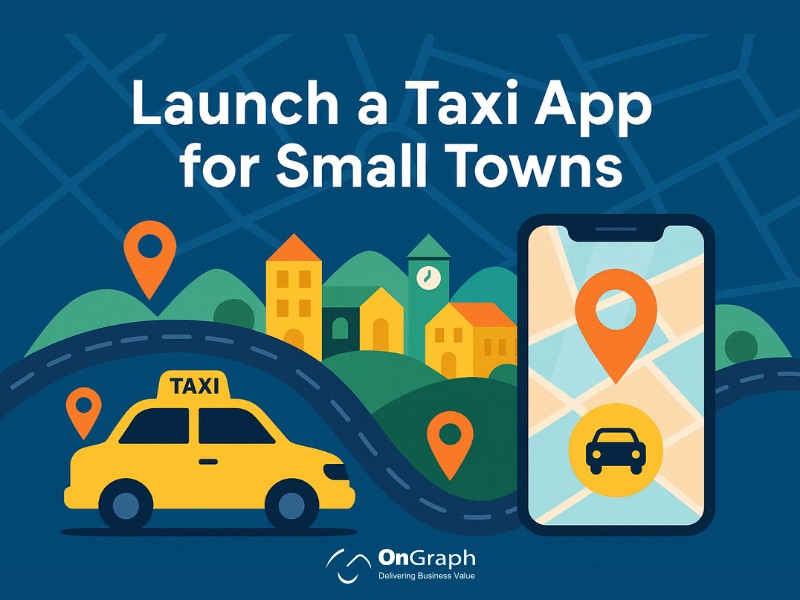In this article
- The Evolution of Taxi Apps: From Manual Dispatch to AI-Driven Mobility
- How AI Works Inside Modern Taxi and Delivery Apps?
- Real Use Cases of AI in Taxi Apps and Delivery Platforms
- AI for Multi-Service Super Apps
- The Role of AI in Payment Gateway Integration
- AI and Customer Experience: What Riders Expect in 2025
- ROI of AI Adoption in Taxi and Delivery Apps (With Real Numbers)
- AI and Taxi Dispatch Software Cost: What Startups Need to Know
- Future of AI in Taxi Apps: Trends to Watch in 2025 and Beyond
- Final Thoughts
The global ride-hailing and delivery market is changing faster than ever. Startups and enterprises now rely on AI in taxi apps to improve safety, reduce costs, and deliver better customer experiences.
Artificial intelligence is reshaping how drivers get rides, how routes are created, and how pricing works on busy days. In 2025, AI-driven mobility is not a trend. It is a core part of modern transportation systems.
This guide explains how AI works inside ride-hailing and delivery systems. You will see real use cases, updated statistics, and proven benefits that companies experience when they adopt AI-powered mobility solutions.
The Evolution of Taxi Apps: From Manual Dispatch to AI-Driven Mobility
Early taxi systems used simple dispatch models. Calls came into a central desk, and operators manually assigned trips to drivers.
That era is now long gone. Modern mobility platforms use AI-powered ride-sharing algorithms that make decisions in seconds.
Current Industry Stats (2024–2025)
- The global ride-hailing market will reach $260 billion by 2028, driven by automation and AI.
- AI adoption in mobility is increasing by 34% year-over-year, according to multiple industry surveys.
- Cities adopting AI routing models have reduced travel delays by 20–30%.
This evolution shows why AI in ride-hailing apps is becoming essential for companies looking to scale fast.
Also read- The Evolution of Taxi Apps: Everything You Should Know in 2025
How AI Works Inside Modern Taxi and Delivery Apps?
AI processes large amounts of user data, traffic patterns, historical trips, payment behavior, and weather updates. It helps the system recommend the best driver, shortest route, safest pickup, and ideal pricing. AI makes the app smarter with every completed trip.
Below is a simple breakdown of how AI works:
1. AI Matching System
- Matches riders and drivers in real time.
- Reduces waiting time by analyzing nearby driver density.
- Avoids mismatched rides by checking trip suitability and route direction.
This is a core part of machine learning transportation apps used around the world.
2. AI Route Optimization
- Predicts the fastest routes based on live road conditions.
- Avoids traffic, blockages, and high-risk zones.
- Reduces the total cost of operation for drivers and fleet owners.
3. AI-Powered Dynamic Pricing
One of the most powerful features is dynamic pricing AI. It adjusts prices based on:
- High-demand areas
- Event traffic
- Rush hours
- Weather conditions
- Driver availability
This helps companies maintain profit margins even during unpredictable demand spikes.
Real Use Cases of AI in Taxi Apps and Delivery Platforms
Here are practical, real-world functions powered by AI today.
1. Smart Driver Allocation
AI assigns rides based on:
- Distance
- Trip history
- Driver rating
- Fuel efficiency
- Traffic density
This reduces cancellations and increases completed trips.
Results:
Companies using AI allocation algorithms report up to 18% higher trip completion rates.
2. ETA Accuracy and Delay Prediction
Estimated Time of Arrival (ETA) predictions are 40–60% more accurate with AI.
AI analyzes:
- Road speed
- Weather
- Roadblocks
- Traffic jams
- Real-time rider demand
These predictions improve customer trust and reduce support complaints.
3. Fraud Detection and Prevention
AI prevents:
- Fake bookings
- Multiple account abuse
- GPS spoofing
- Payment scams
Fraud detection is now a top reason why companies invest in artificial intelligence taxi apps.
4. AI Chatbots and Booking Automation
AI chat systems help users:
- Book rides
- Track drivers
- Request support
- Make payments
- Modify pickup points
This reduces support costs and boosts user satisfaction.
5. Predictive Driver Incentives
Driver retention is a big challenge.
AI solves this by recommending:
- Best active hours
- Bonus targets
- Peak earning zones
- Suggested routes
This helps drivers stay active longer and improves platform reliability.
6. AI Delivery App Features for Multi-Service Apps
Delivery platforms use AI to power:
- Multi-stop optimization
- Package scanning
- Real-time delivery tracking
- Failed delivery predictions
- Route clustering
These AI delivery app features reduce logistical errors and speed up delivery by up to 25%.
AI for Multi-Service Super Apps
Many companies now build a Taxi App for Multi-Service Platform models. These super apps combine taxi, parcel delivery, food delivery, and home services.
AI helps by:
- Matching service providers
- Estimating task completion times
- Managing real-time workforce distribution
- Predicting service shortages
Multi-service apps using AI report 25–40% faster scaling during launch months.
The Role of AI in Payment Gateway Integration
Payments are central to any mobility system.
AI enhances Taxi App Payment Gateway Integration by:
- Detecting risky transactions
- Ensuring secure wallet operations
- Predicting refund behaviors
- Automating invoice checks
AI-enabled payment systems reduce transaction fraud by up to 45%.
AI and Customer Experience: What Riders Expect in 2025
Customer behavior changed drastically in just two years. Riders now expect:
- Instant ETAs
- Fair pricing
- Safe drivers
- Fast support
- Accurate pickups
AI delivers these expectations by tailoring the experience for every user. Searching patterns show rising adoption of AI in ride-hailing apps among startups aiming for long-term scale.
ROI of AI Adoption in Taxi and Delivery Apps (With Real Numbers)
Implementing AI increases short-term investment but delivers strong returns.
ROI Breakdown (Typical 1-Year Improvements)
- 20–35% lower operational cost
- 18–25% higher driver productivity
- 15–22% increase in completed trips
- 30–40% reduction in fraud
- 12–20% more repeat customers
These numbers explain why so many founders now search for a Taxi App Development Company with AI expertise.
AI and Taxi Dispatch Software Cost: What Startups Need to Know
AI features impact Taxi Dispatch Software Cost, but they also reduce long-term expenses.
Cost increases come from:
- Predictive analytics
- Route optimization engines
- Real-time mapping APIs
- Machine learning model training
- Fraud detection systems
However, AI reduces costs by:
- Lower driver idle time
- Minimizing support calls
- Decreasing fuel waste
- Improving customer retention
- Preventing fraud losses
This makes AI a profitable investment for any ride-hailing business.
Future of AI in Taxi Apps: Trends to Watch in 2025 and Beyond
1. Autonomous fleet signals
Autonomous fleets are still in early stages, but will grow in controlled environments.
2. Predictive demand heatmaps
Apps will predict where rides will be needed before demand rises.
3. Voice-activated ride booking
Voice systems will support ride booking inside apps and wearable devices.
4. Smarter pool ride suggestions
AI will improve shared-ride suggestions to reduce fares.
5. Carbon tracking for sustainable rides
AI will calculate the carbon impact of every trip.
The future shows deeper automation and smarter mobility decisions.
Final Thoughts
AI is changing every part of mobility. Companies using AI in taxi apps report stronger operational control, better user retention, improved driver efficiency, and higher revenue.
The rise of on-demand delivery and multi-service super apps makes AI even more important. Artificial intelligence is not optional anymore. It is a core part of successful mobility platforms in 2025.
FAQs
AI in taxi apps uses data, predictions, and automation to improve ride matching, pricing, routing, and customer experience. It makes mobility apps more accurate, faster, and safer for users and drivers.
AI improves ride-hailing apps by predicting demand, reducing waiting times, suggesting faster routes, and optimizing pricing. It also improves fraud detection and driver performance.
AI delivery app features include route optimization, multi-stop planning, demand forecasting, delivery probability prediction, automated dispatching, and live tracking.
Yes. AI lowers operational costs by cutting idle time, reducing support needs, improving routing, and reducing cancellations. It also enhances fraud protection.
Dynamic pricing AI adjusts fare prices based on demand, driver availability, weather, and traffic. It ensures balanced earnings for drivers and reduces rider cancellations during peak hours.
AI may increase initial development cost because it requires machine learning models, prediction engines, and mapping algorithms. But the long-term savings far outweigh the investment.
Yes. AI works perfectly for multi-service apps offering taxi rides, delivery, home services, and logistics. It manages task distribution, ETA accuracy, and workforce forecasting across all service types.
About the Author
Let’s Create Something Great Together!
Latest Blog















